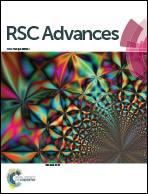Mechanically stable superhydrophobic polymer films by a simple hot press lamination and peeling process†
Abstract
Mechanically stable superhydrophobic polymer films were prepared from a blend of polypropylene (PP) and ultrahigh molecular weight polyethylene (UHMWPE) polymers using a simple hot-press lamination and peeling method. The film's surface morphology, wetting characteristics and resistance against wear abrasion were studied for varying PP/UHMWPE blend ratios. At a minute scale, the superhydrophobic surface was extensively covered with small fibrous protrusions having sizes in the micron to sub-micron range while at larger scales some bigger sized protrusions were also present on the film's surface. The number of bigger protrusions was found to increase with increasing UHMWPE content of the PP/UHMWPE blend films, simultaneously enhancing the wear abrasion resistance and friction characteristics of the films. The bigger sized protrusions on the surface acted as sacrificial protrusions during the wear abrasion of the surface leaving the finer fibrous structures unaffected. The work demonstrated the possibility of producing polymer films with a mechanically stable superhydrophobic surface by a simple hot-press lamination and peeling method which is facile, environmentally friendly and adaptable for mass-production.


 Please wait while we load your content...
Please wait while we load your content...